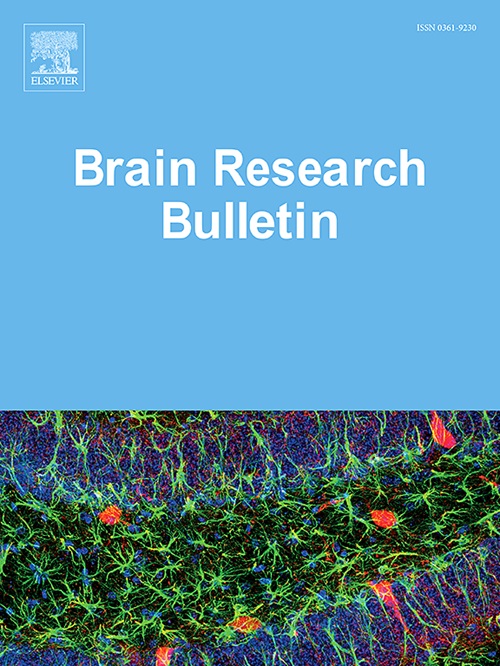NLRP3 in the dorsal raphe nucleus manipulates the depressive-like behaviors
IF 3.7
3区 医学
Q2 NEUROSCIENCES
引用次数: 0
Abstract
Major depressive disorder is one of the most common psychiatric disorders, and the Nod-like receptor family pyrin domain containing 3 (NLRP3) inflammasome plays an important role in depression. Dorsal raphe nucleus (DRN), as the main origin of producing serotonin in the brain, is an important functional brain region in depressive disorders. However, the relationship between NLRP3 in the DRN and depression has not been clarified in previous studies. So, we focus on demonstrating the role of NLRP3 expressed in DRN in depression. In this study, the male C57BL/6 J mice were exposed to chronic unpredictable mild stimulation and the expression and cellular localization of NLRP3 in DRN were analyzed. Subsequently, the mice were treated with the NLRP3 inhibitor MCC950 to inhibit NLRP3 inflammasome, and the expression of NLRP3 was knocked down in certain cells within the DRN of NLRP3fl/fl mice to investigate the role of NLRP3 in regulating depressive phenotype. Compared with the control group, the expression of NLRP3 in DRN of CUMS group was significantly increased, especially in the microglia and neuron. Furthermore, treatment with the NLRP3 inhibitor induced a significant antidepressant effect, and the depressive phenotype of NLRP3fl/fl mice was rescued after knocking down NLRP3 in the microglia or neuron. In addition, the expression levels of related molecules in the NLRP3 inflammasome pathway were significantly higher in the CUMS group compared to the control group. These results illustrated that NLRP3 played an important role in regulating depressive phenotype in DRN, and suggested a new therapy target for depression.
中缝背核的NLRP3控制抑郁样行为
重度抑郁症是最常见的精神疾病之一,而nod样受体家族pyrin domain containing 3 (NLRP3)炎性小体在抑郁症中起着重要作用。中隔背核(Dorsal raphe nucleus, DRN)是大脑中产生5 -羟色胺的主要来源,是抑郁症的重要功能脑区。然而,在以往的研究中,DRN中NLRP3与抑郁症之间的关系尚未明确。因此,我们将重点研究DRN中表达的NLRP3在抑郁症中的作用。本研究将雄性C57BL/6 J小鼠置于慢性不可预测的轻度刺激下,分析NLRP3在DRN中的表达和细胞定位。随后,用NLRP3抑制剂MCC950处理小鼠,抑制NLRP3炎性体,并在NLRP3fl/fl小鼠的DRN内敲低NLRP3的表达,研究NLRP3在调节抑郁表型中的作用。与对照组相比,CUMS组DRN中NLRP3的表达明显增加,尤其是在小胶质细胞和神经元中。此外,用NLRP3抑制剂治疗可诱导显著的抗抑郁作用,在小胶质细胞或神经元中敲除NLRP3后,NLRP3fl/fl小鼠的抑郁表型得以恢复。此外,与对照组相比,CUMS组NLRP3炎性小体通路相关分子的表达水平显著升高。这些结果表明NLRP3在DRN的抑郁表型调控中发挥了重要作用,为抑郁症的治疗提供了新的靶点。
本文章由计算机程序翻译,如有差异,请以英文原文为准。
求助全文
约1分钟内获得全文
求助全文
来源期刊

Brain Research Bulletin
医学-神经科学
CiteScore
6.90
自引率
2.60%
发文量
253
审稿时长
67 days
期刊介绍:
The Brain Research Bulletin (BRB) aims to publish novel work that advances our knowledge of molecular and cellular mechanisms that underlie neural network properties associated with behavior, cognition and other brain functions during neurodevelopment and in the adult. Although clinical research is out of the Journal''s scope, the BRB also aims to publish translation research that provides insight into biological mechanisms and processes associated with neurodegeneration mechanisms, neurological diseases and neuropsychiatric disorders. The Journal is especially interested in research using novel methodologies, such as optogenetics, multielectrode array recordings and life imaging in wild-type and genetically-modified animal models, with the goal to advance our understanding of how neurons, glia and networks function in vivo.
 求助内容:
求助内容: 应助结果提醒方式:
应助结果提醒方式:


